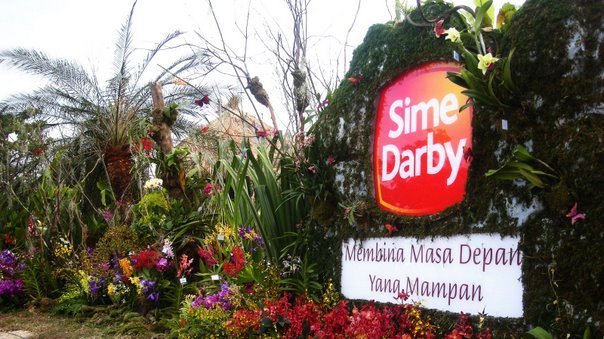05/04/2011 (The Star) - Sime Darby Plantation Sdn Bhd, a unit of Sime Darby Bhd, yesterday signed a memorandum of understanding (MoU) with Malaysia's national power producer, Tenaga Nasional Bhd (TNB), and Japanese industrial conglomerate Mitsui & Co Ltd to conduct a feasibility study on the potential of biogas projects at eight of its palm oil mills spread across Peninsular Malaysia.
The two-year study will involve the technical feasibility, financial viability and undertaking the necessary preliminary development works for implementation of potential biogas power-generation projects.
“It is a timely study because today the world continues to grapple with the issue of depleting sources of energy and environmental protection,” Sime Darby Plantation executive vice-president Franki Anthony Dass said in his speech.
“We are confident that the result of the study would be positive and that the three parties would come out of the feasibility study with the proper data to generate electricity at our palm oil mills and further strengthen their green credentials.”
If results of the study show commercial viability, TNB will assist in connectivity of the green power generated to the national grid as well as operations and maintenance expertise, while Mitsui will contribute towards technical design and carbon financing.
Sime Darby Plantation, on the other hand, will provide plant sites through the palm oil mills it operates. According to Dass, by then, biogas production for power generation will no longer be constrained in the eight mills involved in the feasibility study, but also in other mills belonging to the company.
Sime Darby Plantation currently has 62 palm oil mills, of which 40 are in Malaysia and the rest in Indonesia.
“The development of renewable energy projects, such as that of biogas, is timely as it contributes towards the Government's aspirations,” TNB chief operation officer Datuk Ir Azman Mohd explained.
At present, the renewable energy industry is still at its infancy stage in Malaysia, contributing less than 1% to the country's total energy mix. But the Government has recently outlined its plan to have renewable energy generating about 5.5%, or 985 megawatt (MW), of the total electricity generated in the country by 2015, and to eventually increase that to 11%, or 2,080MW, by 2020.
TNB, being a front-runner in the renewable energy in the country, has thus far signed 21 renewable energy power-purchase agreements, which account for a total capacity of 291MW, in the country.
Biogas Power-Generation
31/01/2011 (Eco-Business.com), Singapore - Defunct first-generation (1-G) biodiesel plants - which became uneconomical when palm oil prices soared - are being revived as new owners upgrade them to make other products like chemicals used for oil and gas drilling.
The ‘rejuvenation’ of Northfield-based Stepan Company is the first of these. After acquiring Peter Cremer’s 100,000 tonnes per annum (tpa) methyl ester plant in July last year, the American chemicals company is currently upgrading it and installing another fractionation column at the Singapore plant to potentially double its capacity to 200,000 tpa.
The plant’s upgrading and expansion, scheduled for completion in February next year, will enable Stepan to produce surfactants used in oilfields. Stepan’s surfactants are used in three major oilfield market segments, including drilling, production and stimulation. Methyl esters are for instance used as solvents in drilling fluids.
Another Jurong Island 1-G biodiesel plant which looks set to go the same route is the $130 million Jurong Island plant (once touted as the world’s largest biodiesel facility) of Australian-owned Natural Fuel Pte Ltd. The plant which folded up in late-2009 is understood to have changed hands recently. But no details are available at this time.
President and CEO of Stepan, F Quinn Stepan Jr said at the time of its acquisition of Peter Cremer that: ‘Methyl esters are a core building block of Stepan’s surfactant business and the acquisition of this asset on Singapore’s Jurong Island provides a great opportunity to reach our global customer base with methyl esters (ME) and value added derivatives.’
‘Our plan is to install methyl ester fractionation capability on the site in order to supply our customers and our internal surfactant needs globally with fractionated methyl esters and derivatives made from tropical oils available in the region.’
The financial terms of the acquisition of the US$20 million plant - previously a joint venture involving Germany’s Peter Kremer and Malaysia’s Kulim Berhad - were not disclosed.
Stepan just over a week ago awarded a $14.6 million contract to Rotary Engineering to build a new four-storey 50,000 tpa (expandable to 100,000 tpa) fractionated ME plant and also upgrade the existing plant. The plant is expected to tap raw materials like palm oil and coconut from this region.
The early 1-G plants here like Natural Fuel and Peter Cremer, and a third plant belonging to Continental BioEnergy, essentially fell victim to soaring palm oil prices. Palm oil prices had tripled to US$1,400- plus a tonne by March 2008 from US$450 a tonne around 2005/06 when the Jurong Island plants first started.
Given also stiff competition from the many rival biodiesel plants in neighbouring palm oil producing countries, Malaysia and Indonesia, Singapore has been promoting more advanced 2-G plants, or second generation plants, with biofuels developed from non-edible or discarded plant parts.
Finland’s Neste Oil which expects to ramp up its just-started $1.2 billion biodiesel plant at Tuas to full production by mid-year, exemplifies such 2-G technology.
Its 800,000 tpa Singapore plant - the largest in the world, with an identical new twin plant in Rotterdam starting up also around mid-year - produces biodiesel from 100 per cent renewable materials like palm oil and animal fat. Its advanced 2-G refineries allow Neste Oil to produce biodiesel from straight processing of the raw materials.
The Economic Development Board, in a background note to a recent tender for a consultant, said: ‘EDB believes bio-based feedstocks could add a new dimension of chemical feedstock option on Jurong Island. The fast-growing bio-based chemicals industry would also create new economic opportunities for Singapore.’
SIngapore Biodiesel Plants






























